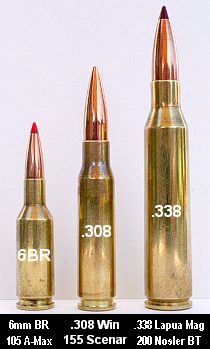The .300 Lapua Magnum (30-338) — Big Power for Big Game

Not many folks are familiar with the .300 Lapua Magnum, but this big boomer is an official CIP-certified cartridge for which Vihtavuori offers load data. This necked-down version of the .338 Lapua Magnum makes one heck of a hunting cartridge. In our article on the .300 Lapua Magnum (aka 30-338 LM), you’ll find expert advice on forming the cases from .338 Lapua Magnum brass plus tips on selecting powder and bullets. The story also features some great photos of a 30-338 custom Richard Franklin built for a California client. That rifle is designed as an Elk Gun, shooting the 190gr Berger VLDs with Reloder 22 powder. The laminated stock is made from exhibition-grade Claro Crotch Walnut and Dennis Smith (aka the Stock Doctor) provided beautiful checkering and a hand-rubbed oil finish.

 Ultimate Varmint Cartridge?
Ultimate Varmint Cartridge?
Franklin has also pioneered an ultra-high-velocity varmint version of the 30-338 LM. This cartidge achieves amazing 30-Cal velocities using long, very slow-twist barrels. Richard tells us: “I use 15- to 17-twist barrels with both the 300 WSM Varminter and the 30-338 Lapua Varminter. The 300 WSM easily gets 3900 fps with the Nosler 125gr Ballistic Tip and the 30-338 Lapua will do 4150 fps easily with the same 125gr B-Tip. In the 30-338 LM, the 130gr Barnes, a “ringed” bullet with grooves to reduce bearing surface, will get another 150 fps, topping out at 4300 fps. I find the 17-twist does a good job with the light bullets in the 30-338 but I’m going to try an 18-twist and a 19-twist to see if high velocity is a little more easier to obtain. I believe the 19-twist will beat any thing I’ve built to date for velocity and I also believe it’s going to be very accurate.”
The “Official” .300 Lapua Magnum
While nearly every 30-338 you see in the USA is a wildcat, manually formed by necking-down the .338 Lapua brass, there was an “official” version, the “.300 Lapua Magnum”. This was a factory 30-caliber cartridge based on the .338 Lapua Magnum parent case. Lapua produced enough factory ammo to get the .300 Lapua Magnum sanctioned as an official CIP-certified cartridge. QuickLOAD includes the .300 Lapua Magnum in its load database, and QuickDESIGN has complete CIP cartridge specifications. Unfortunately, the .300 Lapua Magnum is no longer in production. For you cartridge collectors, we’re not even sure if Lapua ever produced brass with a distinctive “300 Lapua Magnum” headstamp. However Vihtavuori does include .300 Lapua Magnum load data in the current Vihtavuori Load Manual. That reloading guide shows the .300 Lapua Magnum can drive a 220gr HPBT Sierra MatchKing at 3044 fps with a max charge of VV 24N41 powder. The .300 Lapua Magnum can push the 30-caliber 155gr Lapua Scenar at nearly 3500 fps with VV N170 powder. That’s impressive performance indeed!
CLICK HERE to download Current Vihtavuori RELOADING MANUAL (35-page .pdf file).
















 The new rifle features a single-shot Magnum Target Action coupled to a 26″ heavy barrel fitted with a big muzzle brake. The Target AccuTrigger adjusts to a minimum pull-weight of 6 ounces. Rifle weight, without scope, is 12 pounds. The gray/brown laminated stock features a near-vertical grip with a moderate amount of drop in the buttstock. We’ve used this same-type stock on other Savages. It is comfortable and works well with a bipod. However, you may want to add a “bag-rider” in the rear for better tracking.
The new rifle features a single-shot Magnum Target Action coupled to a 26″ heavy barrel fitted with a big muzzle brake. The Target AccuTrigger adjusts to a minimum pull-weight of 6 ounces. Rifle weight, without scope, is 12 pounds. The gray/brown laminated stock features a near-vertical grip with a moderate amount of drop in the buttstock. We’ve used this same-type stock on other Savages. It is comfortable and works well with a bipod. However, you may want to add a “bag-rider” in the rear for better tracking.
 Forum member Rich DeSimone uses a handy “Stub Gauge” for setting shoulder “bump” and seating depth. The gauge is made from a section of barrel lopped off when the muzzle is crowned. The chambering reamer is run in about 1/4 of the way, enough to capture the neck and shoulder area of the case. Rich then uses his full-length die to “bump” a master case with the ideal amount of headspace for easy feeding and extraction. He takes that case and sets it in this Stub Gauge, and measures from the front of the gauge to the rim. He can then quickly compare any fired case to a his “master” case with optimal headspace. Since the gauge measures off the shoulder datum, this tells him how much to bump his fired brass.
Forum member Rich DeSimone uses a handy “Stub Gauge” for setting shoulder “bump” and seating depth. The gauge is made from a section of barrel lopped off when the muzzle is crowned. The chambering reamer is run in about 1/4 of the way, enough to capture the neck and shoulder area of the case. Rich then uses his full-length die to “bump” a master case with the ideal amount of headspace for easy feeding and extraction. He takes that case and sets it in this Stub Gauge, and measures from the front of the gauge to the rim. He can then quickly compare any fired case to a his “master” case with optimal headspace. Since the gauge measures off the shoulder datum, this tells him how much to bump his fired brass.




